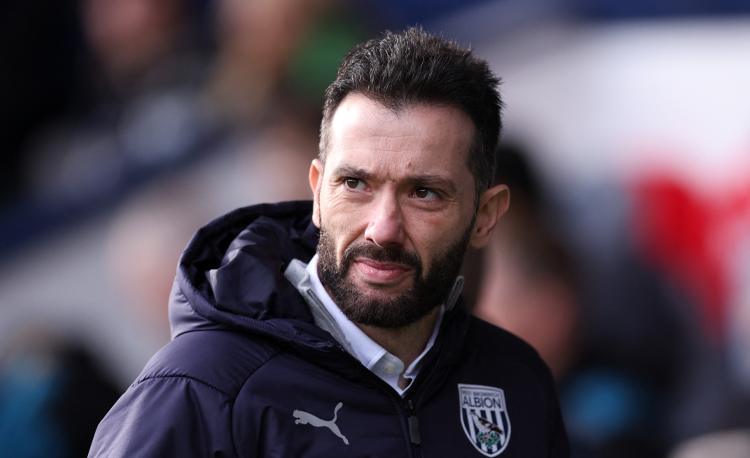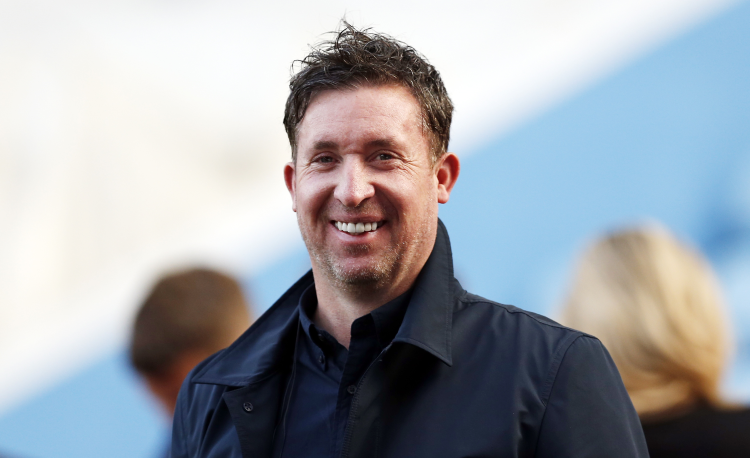You are viewing 1 of your 1 free articles
Building up
This session is about building up play from the goalkeeper and the centre backs and it is intended to develop and improve circulation and decision making on the pitch.
| Area | Up to three quarters of pitch |
| Equipment | Balls, bibs, cones, 2 full size goals |
| No. of Players | 20 players + 2 goalkeepers |
| Session Time | Ball possession: 12mins Playing through the zones: 24mins Offensive organisation: 24mins |
This session is about building up play from the goalkeeper and the centre backs and it is intended to develop and improve circulation and decision making on the pitch. What we want to see is the centre backs making the best decisions for the circumstances and improving the connection between the different units.
We chose this session because it is important for our offensive organisation and build-up play to have the initiative in games.
We run this type of session every 15 days, always at the beginning of the week, especially on MD-3 when we use big spaces and big numbers.
“This session is about building up play from the goalkeeper and the centre backs and it is intended to develop and improve circulation and decision making”
BALL POSSESSION
We set up a playing area of 44x34 yards, split into a 16-yard centre zone and two 14-yard end zones, as shown in the below diagram.
We’re using 19 outfield players, split into a red pressing team of six, a blue possession team of six, five yellows who support the possession team and two greens floaters who play for the team trying to recover the ball. The yellows start with one player in each corner of the playing area representing centre backs and one yellow midfielder in the centre zone. The reds and blues go up against each other in a 4v4 in the centre zone and there is also one red, one blue and one green in each of the end zones.
The coach plays a ball into one of the yellow centre backs to start the practice. The aim is to utilise the 3v2 overload of the yellows and the blues and pass the ball around with one-touch and play through the centre zone, where the blues and the yellow midfielder (who is on two touches) combine to create a 5v4 overload. The aim is to play forwards whenever possible and find a yellow player at the opposite end to pass to, as shown [1a].
[1a]

2. The yellows combine with the blue possession team to play forwards whenever possible
3. The aim is to pass to a yellow at the opposite end. The blues and the yellows must try to continually transfer the ball from one end to the other and back without losing possession
[1b]

2. If the blue possession team gives the ball away and it is won by a green floater, the green must pass to either a red player or a yellow centre back
3. The reds now become the team in possession and the practice continues with the same aims and overloads in each zone, with the reds combining with the yellows
“The possession team must try to continually transfer the ball from one end to the other and back without losing possession”
The possession team must try to continually transfer the ball from one end to the other and back again, without losing possession. If the team in possession gives the ball away and it is regained by a green floater, the green plays without restrictions until a pass can be made to either a red player or a yellow centre back, as shown [1b]. The red team now become the team in possession and the practice continues with the same aims and overloads in each zone.
We play for blocks of between four minutes and 12 minutes. The intention is to develop the ball movement between defenders, in particular the centre backs, as these have an important role to play in achieving the type of game we want.
PLAYING THROUGH THE ZONES
We set up a playing area of 65x44 yards split into two 20-yard end zones and a 25-yard centre zone. We position a full size goal and a goalkeeper at each end.
We’re using 17 outfield players split into two teams of eight plus goalkeepers and one neutral midfielder, who is positioned in the central zone and who plays for the team in possession. Each team is made up of two defenders, three midfielders and three forwards, playing in a 2-3-3 formation.
Play starts from the goalkeeper, who initiates the build-up through the centre backs. When out of possession two of the opposition team’s forwards must retreat into the central zone, allowing the possession team’s two centre backs to enjoy a 2v1 overload as they play out of the end zone and move the ball into and through the middle zone.
If a centre back steps forward into the middle zone, they must be replaced in the defensive end zone by the possession team’s nearest midfield player, as shown [2a].
Two of the forwards for the team in possession can choose to drop into the middle zone to create a 6v5 overload (including the neutral player) and receive between the defensive lines. The aim is to play through and beyond the final defensive line and produce a finish on goal.
[2a]

2. When out of possession two of the opposition forwards must start in the central zone, allowing the possession team’s centre backs to enjoy a 2v1 overload as they play out of the end zone
3. If a centre back steps into the middle zone, they must be replaced in the defensive end zone by the possession team’s nearest midfield player
4. Two of the forwards for the team in possession can drop into the middle zone to create a 6v5 overload (including the neutral player) and receive between the defensive lines
5. The aim is to play through and beyond the final defensive line and produce a finish
“When the opposing team wins the ball, in transition the team losing possession must recover to their initial shape”
[2b]

2. When out of possession two of the opposition forwards retreat into the central zone, allowing the centre backs to play out from the back
3. Here the yellow neutral gives the possession team an overload in midfield
If the possession team scores or if the ball goes out of play, the opposition goalkeeper restarts play with a pass out to the centre backs and the game works in the opposite direction in the same way, as shown [2b].
When the opposing team wins the ball, in transition the team losing possession must recover to their initial shape, meaning that the players that changed zones must return to their starting zones.
We play for blocks of between six minutes and 12 minutes each.
OFFENSIVE ORGANISATION
[3a]

2. The blue team aims to play through and between the two defensive lines of four that the red team have positioned between the halfway line and the yellow line
3. The blues combine and play beyond the yellow line for runners to create chances and score goals
We set up a playing area on half a pitch plus 30 yards and we position a full size goal and a goalkeeper at each end. The halfway line is still used to separate the two unequal parts of the playing area and a yellow line sets the initial position of the out-of-possession team’s defenders.
We’re using 20 outfield players split into two teams of 11 including goalkeepers. The blue team starts in possession and is set up in a 4-4-2 formation, with the two centre backs and two midfielders in their own half and the full backs, the wingers and the two forwards in the opposition’s half. The red team is also set up in a 4-4-2 formation with the defensive line and the midfield line in their own half and the two forwards in the opponent’s half.
The practice starts from the blue team’s goalkeeper, who can use the two blue centre backs and the two blue central midfield players to create a 4v2 overload situation in the build-up from the back. The blue team aims to play through and between the two defensive lines of four that the red team have positioned between the halfway line and the yellow line. The aim for the blues is to combine and play beyond the yellow line for runners to create chances and score a goal, as shown [3a].
[3b]

2. Once the red team gets over the halfway line, one blue midfield player or full back can recover to support the two centre backs to defend against four red attackers
“In transition the red team counter-attack and they aim to score a goal as quickly as possible”
If the blue possession team gives the ball away when attacking, then the red team looks to break forwards quickly in transition. Once the red team gets over the halfway line, one blue midfield player or full back can recover to support the two centre backs to defend against four red attackers, creating a 4v3 overload situation in favour of the reds, as shown [3b]. In transition the red team counter-attack and they aim to score a goal as quickly as possible.
We play for blocks of between six minutes and 12 minutes each.
Related Files
Editor's Picks
Using the goalkeeper in build-up play
Pressing principles
Intensive boxes drill with goals
Penetrating the final third
Creating and finishing
My philosophy
Pressing initiation
Compact team movement
Defensive organisation
Coaches' Testimonials

Alan Pardew

Arsène Wenger

Brendan Rodgers

Carlos Carvalhal

José Mourinho

Jürgen Klopp

Pep Guardiola

Roy Hodgson

Sir Alex Ferguson

Steven Gerrard
Related
Coaches' Testimonials

Gerald Kearney, Downtown Las Vegas Soccer Club

Paul Butler, Florida, USA

Rick Shields, Springboro, USA

Tony Green, Pierrefonds Titans, Quebec, Canada
Join the world's leading coaches and managers and discover for yourself one of the best kept secrets in coaching. No other training tool on the planet is written or read by the calibre of names you’ll find in Elite Soccer.
In a recent survey 92% of subscribers said Elite Soccer makes them more confident, 89% said it makes them a more effective coach and 91% said it makes them more inspired.
Get Monthly Inspiration
All the latest techniques and approaches
Since 2010 Elite Soccer has given subscribers exclusive insight into the training ground practices of the world’s best coaches. Published in partnership with the League Managers Association we have unparalleled access to the leading lights in the English leagues, as well as a host of international managers.
Elite Soccer exclusively features sessions written by the coaches themselves. There are no observed sessions and no sessions “in the style of”, just first-hand advice delivered direct to you from the coach.









